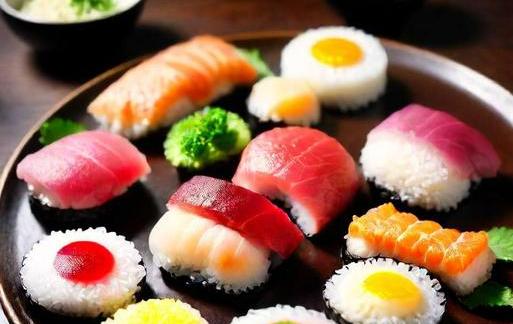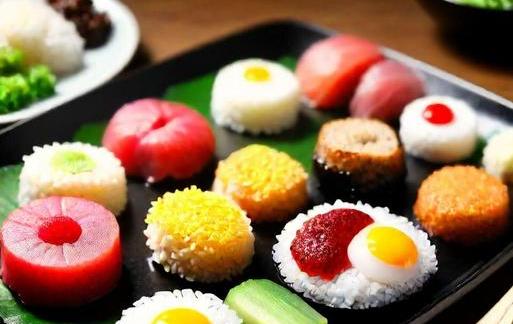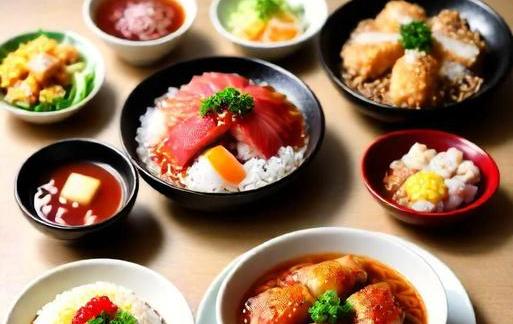- You are here:
- Home »
- Food
- » [REVEALED] Japanese Foods That Start With W
[REVEALED] Japanese Foods That Start With W
Note: This page contains affiliate links.
As an Amazon Associate, I earn from qualifying purchases when you click on the link, but you are not charged extra.
Japanese cuisine is renowned for its rich diversity and exquisite flavors. From sushi to ramen, the culinary landscape is a tapestry of unique dishes that reflect a perfect blend of tradition and innovation. In this gastronomic journey, we will delve into the lesser-explored realm of Japanese foods that start with the letter ‘W’. While not as common as some other letters, ‘W’ offers a fascinating array of dishes that showcase the creativity and craftsmanship of Japanese culinary culture.
Contents
List Of Japanese Foods That Start With W

1. Wagashi (和菓子)
Wagashi, the traditional Japanese confectioneries, are a delightful embodiment of the country’s artistry and attention to detail. These sweets are often enjoyed with tea during traditional ceremonies such as the tea ceremony (茶道, sadō). Made from ingredients like sweet bean paste, mochi (glutinous rice cake), and sugar, wagashi comes in various shapes and colors, each representing different seasons and occasions. Examples include ‘daifuku’ (mochi filled with sweet bean paste), ‘yokan’ (sweet bean jelly), and ‘manjū’ (steamed buns with various fillings).
2. Wakame (ワカメ)
Wakame, a type of edible seaweed, is a staple in Japanese cuisine. It is often used in salads, miso soup, and as a side dish. With a mild flavor and tender texture, wakame adds a touch of umami to a variety of dishes. Rich in vitamins and minerals, this seaweed not only enhances the taste but also contributes to the overall nutritional value of the meal.
3. Wanko Soba (わんこそば)
Originating from Iwate Prefecture, Wanko Soba is a unique and entertaining way of serving soba noodles. In this dining experience, small portions of soba are served in rapid succession, and diners are encouraged to eat as much as they can. The small bowls are continuously refilled by attentive servers, creating a lively and enjoyable atmosphere. Wanko Soba is not only a delicious culinary experience but also a cultural one, offering a glimpse into the conviviality that is characteristic of Japanese dining traditions.
4. Wasabi (わさび)
Wasabi, known for its pungent flavor and distinctive green color, is a condiment often paired with sushi and sashimi. Derived from the Japanese horseradish plant, the root is grated into a paste and served alongside raw fish to add a spicy kick. True wasabi is highly prized for its nuanced taste, and its cultivation requires specific conditions. While imitation wasabi made from horseradish and mustard is more common, the authentic experience of freshly grated wasabi is a must-try for any connoisseur of Japanese cuisine.
5. White Rice (白ご飯 – Hakumai)
While rice might seem like a generic inclusion, the significance of white rice in Japanese cuisine cannot be overstated. Referred to as "hakumai" in Japanese, it serves as the foundation of many meals. The meticulous cultivation and preparation of rice are deeply ingrained in Japanese culture. Whether enjoyed as part of a sushi roll, as a side dish, or as the main component of a meal, white rice is a fundamental element that embodies the simplicity and elegance of Japanese gastronomy.
6. Wafu Pasta (和風パスタ)
Wafu Pasta is a Japanese adaptation of the Italian classic, infused with Japanese flavors and ingredients. The term "wafu" translates to "Japanese style," and in the context of pasta, it involves incorporating traditional Japanese seasonings and toppings. This fusion results in unique and flavorful pasta dishes that might include ingredients such as soy sauce, sesame oil, nori (seaweed), and bonito flakes. Wafu Pasta showcases the adaptability of Japanese cuisine, blending global influences seamlessly with local tastes.
7. Wakasagi No Tempura (わかさぎの天ぷら)
Wakasagi, a small freshwater fish, takes on a delicious transformation when prepared as tempura. Tempura, a cooking technique introduced to Japan by Portuguese missionaries in the 16th century, involves coating ingredients in a light batter and deep-frying them to crispy perfection. Wakasagi no Tempura is a popular dish, particularly during the winter months when these small fish are abundant. The result is a delightful combination of crunchy texture and delicate flavor, making it a favorite among tempura enthusiasts.
8. Warabi Mochi (わらび餅)
Warabi Mochi is a jelly-like confection made from bracken starch, giving it a unique chewy texture. Unlike traditional mochi made from glutinous rice, warabi mochi has a translucent appearance and is often coated with kinako (roasted soybean flour) to enhance its flavor. Served chilled, it is a refreshing and delightful treat, especially during the warmer months. Warabi mochi showcases the diversity of mochi-based sweets in Japanese cuisine, offering a departure from the more familiar varieties.
9. Wakadori Karaage (若鶏唐揚げ)
Karaage, a popular Japanese cooking method involving deep-frying, takes a youthful twist with Wakadori Karaage, where "wakadori" refers to young chicken. Bite-sized pieces of marinated young chicken are coated in a seasoned flour mixture and deep-fried to perfection. The result is a crispy and flavorful dish that highlights the tenderness of young chicken. Often served with a side of lemon or a dipping sauce, Wakadori Karaage is a favorite among those who appreciate the art of Japanese fried cuisine.
10. Wagyu (和牛)
Wagyu, often considered the epitome of premium beef, is a highly prized and sought-after ingredient in Japanese cuisine. The term "wagyu" literally means "Japanese cow," and it refers to several breeds known for their marbled and tender meat. From succulent steaks to mouthwatering yakiniku (Japanese barbecue), wagyu elevates the dining experience with its unparalleled quality. Each bite of wagyu is a testament to the meticulous care and craftsmanship that goes into raising these exceptional cattle.
In this exploration of Japanese foods that start with the letter 'W', we've uncovered a diverse array of dishes that exemplify the depth and variety within Japanese cuisine. From the traditional sweetness of Wagashi to the savory delights of Wakasagi no Tempura, each dish contributes to the rich tapestry of flavors that define Japanese gastronomy. Japanese cuisine, with its emphasis on fresh, seasonal ingredients and meticulous preparation, continues to captivate the palates of food enthusiasts worldwide. The incorporation of unique flavors, such as wasabi and wakame, showcases the ability of Japanese chefs to elevate even the simplest ingredients into culinary masterpieces. As we savor the nuances of wafu pasta and indulge in the tenderness of wagyu, it becomes clear that the letter 'W' in Japanese cuisine is not just a letter; it's a gateway to a world of taste experiences waiting to be explored. So, whether you're a seasoned food adventurer or a newcomer to the world of Japanese cuisine, these 'W' dishes offer a delectable journey into the heart of culinary excellence.
Significance

Japanese cuisine is renowned worldwide for its rich flavors, meticulous preparation, and diverse range of dishes. In this gastronomic journey, we delve into the intriguing realm of Japanese foods that start with the letter "W." From traditional favorites to lesser-known gems, the culinary landscape of Japan is a treasure trove waiting to be explored.
Understanding the significance of Japanese foods that begin with "W" requires a glimpse into the broader culinary traditions of Japan. The country’s cuisine is deeply rooted in a respect for ingredients, a balance of flavors, and an artful presentation. Each dish reflects a harmonious blend of cultural, historical, and regional influences, making the exploration of specific categories a fascinating endeavor.
Category-Related Japanese Foods

1. Wagyu (和牛)
Description:
Wagyu, a term meaning "Japanese cow," refers to several breeds of cattle known for their marbled and tender meat. It has gained global acclaim for its exceptional quality and taste. Wagyu beef is often enjoyed in various forms, including sukiyaki, shabu-shabu, and yakiniku.
Preparation:
The cattle are raised with meticulous care, and their diet is a crucial factor in achieving the desired marbling. Wagyu beef is commonly prepared by grilling, boiling, or thinly slicing for hot pot dishes.
2. Wakame (ワカメ)
Description:
Wakame is a type of edible seaweed that plays a prominent role in Japanese cuisine. With its delicate flavor and vibrant green color, wakame is a staple in soups, salads, and side dishes. It is rich in minerals and adds a nutritious element to meals.
Preparation:
Wakame is often rehydrated before use, and its tender leaves are incorporated into miso soup, sunomono (vinegared dishes), and seaweed salads. The seaweed’s versatility makes it a favorite among Japanese cooks.
3. Wasabi (わさび)
Description:
Wasabi, known for its pungent and sinus-clearing flavor, is a green paste derived from the Japanese horseradish plant. It is a quintessential accompaniment to sushi and sashimi, adding a kick to each bite. Authentic wasabi has a distinct flavor profile compared to imitations.
Preparation:
Wasabi is grated or processed into a paste just before consumption to preserve its flavor. It is often served alongside soy sauce for dipping sushi or mixed into soy sauce for a flavorful dipping sauce.
4. Wonton (ワンタン)
Description:
Wonton, although originally a Chinese dish, has found its way into Japanese cuisine. These dumplings are typically filled with a mixture of ground meat, often pork, and seasonings. In Japan, they are commonly enjoyed as a comforting soup known as "wonton-men."
Preparation:
Wontons are meticulously folded into small, delicate parcels before being boiled or steamed. The resulting dumplings are then served in a flavorful broth, creating a satisfying and heartwarming dish.
Common Themes In Japanese "W" Foods
1. Umami Sensation
Japanese cuisine is renowned for its mastery of umami, the fifth basic taste alongside sweet, sour, salty, and bitter. Many "W" foods, such as Wagyu and wakame, contribute to this umami-rich experience, creating a symphony of flavors in each bite.
2. Artful Presentation
The art of food presentation, known as "sousaku ryori" in Japan, is a fundamental aspect of Japanese culinary culture. Whether it’s the meticulously arranged slices of Wagyu on a grill or the vibrant colors of wakame in a salad, visual appeal is given utmost importance.
3. Culinary Diversity
Japanese cuisine is not confined to a single culinary style; it embraces a wide range of cooking methods and flavors. The inclusion of wonton, a Chinese-inspired dish, showcases the diversity that exists within Japanese gastronomy, reflecting a history of cultural exchange.
Interesting Facts About Japanese "W" Foods
1. Wasabi’s Antibacterial Properties
Beyond its fiery taste, wasabi possesses antibacterial properties that help combat foodborne pathogens. This natural preservative quality has contributed to the historical practice of using wasabi with raw fish in sushi.
2. Wagyu Grading System
Wagyu beef is subjected to a rigorous grading system in Japan, assessing factors such as marbling, color, texture, and fat quality. The highest grade, A5, represents the pinnacle of Wagyu excellence and is a sought-after delicacy.
3. Wakame In Japanese Folklore
Wakame holds cultural significance beyond the dining table. In Japanese folklore, it is associated with longevity and good fortune. The seaweed’s resilient nature and vibrant green color are symbolic of vitality and prosperity.
Conclusion
Exploring Japanese foods that start with the letter "W" unravels a culinary tapestry that intertwines tradition, innovation, and cultural significance. From the prized Wagyu beef to the versatile wakame, each ingredient contributes to the rich mosaic of Japanese cuisine. The umami sensation, artful presentation, and culinary diversity are emblematic of a culinary heritage that continues to captivate and inspire food enthusiasts worldwide. As we savor the flavors of these "W" foods, we not only indulge in gastronomic delights but also embark on a journey through the essence of Japanese culture encapsulated in each dish.


